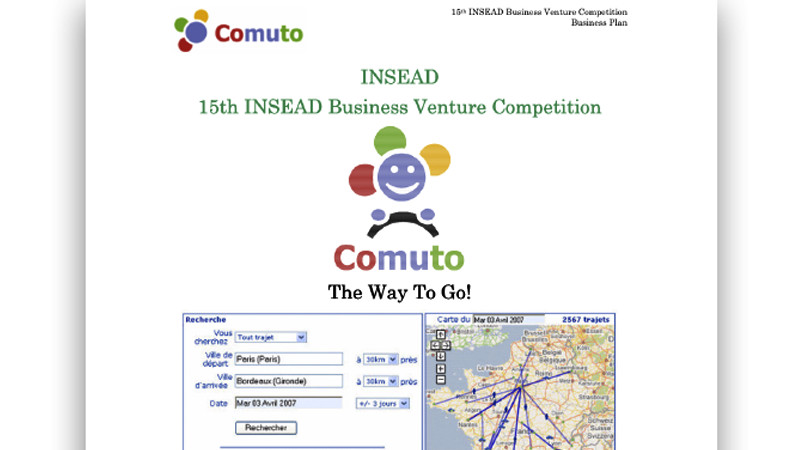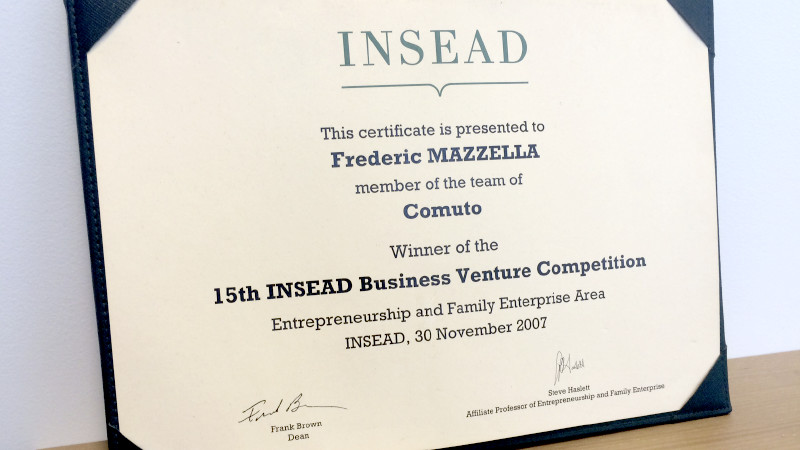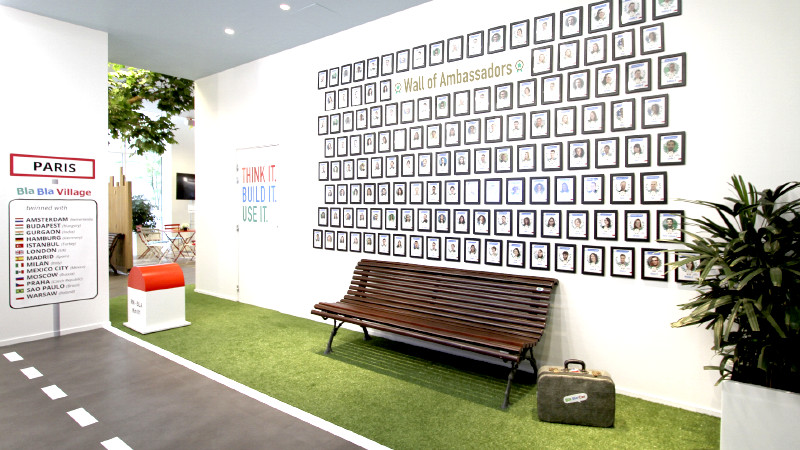On the occasion of BlaBlaCar’s 10 year anniversary, invaluable insights from BlaBlaCar’s founders, employees, investors, sharing economy specialists and members of the community were gathered to take you behind the scenes and shed some light into how BlaBlaCar was built over the years. In a series of 10 articles, each linked to one of BlaBlaCar’s 10 core values, you will discover a decade full of dreams, hard work, passion and fun.
In the first story of the series, the “Think It, Build It, Use It” value mirrors ten years of iteration and progress in building BlaBlaCar’s successful, yet continuously evolving, product.
THINK IT
SOLD OUT. Fred Mazzella kept refreshing the train’s website. Surely there must be at least one train ticket available. At 27 years old, he had never missed a Christmas at home and was determined that 2003 wouldn’t be that year. At 500km away from Paris in the Vendee region of western France, his hometown wasn’t the easiest place to get to without a car. With no seats available on the train until after Christmas, Fred ended up calling his younger sister and convinced her to make a lengthy detour to pick him up in Paris.
Soon after, the siblings were on the road in the old family Honda Civic. It must have been a few hours into the journey when Fred who had been staring out of the window noticed something.
He could see the train from the A10 highway.
The train that he should have been on.
The train that was overbooked and had no seats left.
And whizzing by him were hundreds of cars.
Cars that were mostly empty, except for the driver.
Suddenly he realized what he was actually seeing.
“Oh my god,” he thought, “there ARE seats going to Vendee but they’re not on trains, they’re in CARS!”
For the next 72 hours, Fred couldn’t sleep. Surely a database of empty seats in cars must exist? After searching online, he discovered a handful of listings on various forums with people offering to share a ride. It was at a very low scale and so unorganized that finding someone who was doing the same trip at the same time was next to impossible.
After living through the Silicon Valley boom and adopting a start-up mindset during his studies in Stanford, Fred understood that this could be massive. In each empty car seat, he saw a gap in the market and was convinced that other people would benefit from such an affordable, convenient and friendly transport solution.
Could empty seats in existing cars be the beginning of a new travel network?
Thinking back to his younger years when travelling through Europe, Fred had loved the ease of hitchhiking, but always thought of it as a pinnacle example of a great idea, badly executed. It was impossible to plan ahead, you never knew who you’d be driving with and there was often an awkward money encounter at the petrol station. Feeling guilty for free-riding, Fred would always find a way to contribute. The more he thought about it, the more he realized that hitchhiking is just like a gift that drivers give to passengers, yet not everyone is always ready to give such a gift or even receive such a gift. Add in the possibility of choosing who to travel with and the opportunity to share the costs of the journey, and suddenly a lot more people will open their door. It becomes an exchange of real value.
As Fred honed in on his idea, he knew he didn’t want to develop it alone. He thought back to two of his closest school friends with whom he’d been wanting to start a company with for years and rang them straight away. 24 hours later, as they sat in one of the show model cars at the Renault pop-up store on the Champs-Elysees, Fred pitched them the idea. One of the friends, Damien, instantly loved it. Intense classes of maths, physics and chemistry and long nights of battling equations when they were 18 had set their friendship in stone and Damien was motivated by the challenge. Later that evening over pizza and wine, they started to code straight away.
BUILD IT
For the next two years from 2004 to 2006, Fred together with Damien and Nico D, another good friend and former colleague of Fred, spent their nights, weekends and vacation coding the first version of the carpooling platform whilst holding down their full-time jobs. Fred’s older sister, Helene, who worked in communications helped in the reflection of the project and acted as an advisor over the years. They couldn’t pay themselves a salary, but worked relentlessly because they loved and believed in the product. Few others believed in the idea but this small group knew something great was happening and kept fighting.
With Fred constantly on the lookout for inspiration and ways to further develop the idea, he jumped at the chance to attend weekly meet-ups at his neighbour’s place. Surrounded by a group of young creatives in a 30sqm Parisian living room, it was the chance for burgeoning entrepreneurs to meet up, share ideas and develop new business ventures. And that’s when Fred met his future co-founder Francis Nappez.
From working on a few tech projects together at the weekly meet-up, Fred realized very quickly that Francis was very talented. Having worked as an engineer in some of the biggest names in European consumer internet, he was passionate about the emerging power of internet in transforming everyday lives. Humble and discreet, Fred knew at first glance that Francis was the precious type of person who never over-promises but always over-delivers. With every chance given, Fred would weave his carpooling idea into their conversation and one evening as they said their goodbyes, Francis told Fred, “If you ever want your platform to be accessible on mobile, give me a call”.
A lot happened over the next few months.
With thousands of people now registered on the newly released platform, the decision was taken to incorporate the company under the name “Comuto” in September 2006. It was a big step towards growing the venture and the small team set out to find a way to finance it. They had several ideas in mind, from selling platforms to companies to asking members whether they could contribute to the cost of deploying the platform. As more and more members joined, Fred became even more aware of the amount of work needed to build a robust business from scratch. As a physics major, he felt he lacked some necessary skills in marketing, management and product development, and decided it would be a good time to do an MBA. After announcing his plans to Damien, a rocky period ensued. Damien thought the MBA would eat up all of Fred’s time and eventually lead to the end of the project. There was also worry that Fred would be seduced by new job opportunities along the way. Jobs that offered a real salary.
But Fred followed his instinct and enrolled in the one-year MBA programme at INSEAD Business School in Fontainebleau, close to Paris. For the next year, Fred spoke about the platform to anyone who would listen. He used the platform as an example in all entrepreneurship classes and even incorporated it into the business school’s intranet so students could share their ride between campus and home. Better yet, it’s where Fred met fellow co-founder Nicolas Brusson.
Nicolas, who had recently returned to France after spending seven years working at several startups in Silicon Valley, was in his second semester at INSEAD. Passionate about the startup ecosystem, he had the dream of bringing it to Europe which he felt was seriously lagging behind at the time. Having a keen interest in the Venture Capital world, he was studying the ecosystem through this lens when a mutual friend, Julien Lafouge (now BlaBlaCar’s Latin America Manager), introduced him to Fred. After meeting in one of the cubicles at the business school library, Fred pitched him the beginnings of the BlaBlaCar platform and Nicolas was instantly on board. Having lived next to eBay’s HQ in San Jose, he felt that Fred’s idea was the “eBay of services”. He loved the people-powered aspect and the marketplace dynamic of it. And as for Fred, he loved finding a believer in the project and automatically recognized that they could be complementary partners.
Together with Nicolas and fellow MBA student, Jean-Bernard, the guys drafted a business plan to really transform the project. Long nights were spent in the library trying to structure the plan from product to international growth. Soon it was time for the bi-annual venture competition at INSEAD. A rigorous contest that puts students and their business ideas to the test, it culminates with the best teams pitching their businesses to a panel of investor judges. Placed 4th out of 35 groups, the key concern in their business plan was the uncertainty around the revenue potential of the consumer-focused service. Although slightly disappointed with the result, it was definitely encouraging and propelled them further.
After a busy summer of building platforms with Francis and selling these to companies with Nicolas (who had since graduated from INSEAD), Fred returned to Fontainebleau for his second semester of the MBA. This time, he shared a house with good friend and fellow student, Tracy G. Living outside campus, they would carpool to school in Fred’s car – he had reclaimed the Honda Civic from his younger sister – and in return, Tracy would cook. It was the beginnings of their own version of the sharing economy. Together they re-entered the next business venture competition and prepared a revised business plan with fellow MBA student, Francois B.

And they won! The business plan emphasised that BlaBlaCar would initially rely on selling platforms to companies in order to get some money in along with some traction. When there would be enough liquidity to reach a certain threshold for the marketplace to take off, that’s when they would switch to a consumer-focused model, the model currently in place today. Suddenly the whole venture seemed more viable.

After graduating from INSEAD at the end of 2007, Fred had a big question to face: to find a job or to really jump full-time into the project. Deep down, he knew the answer. He had enrolled in the MBA to develop the idea and now the concept was clearer than ever. Yes, he had a loan to repay for his studies but the deferred repayment date meant he didn’t have to worry too much at the time.
Thus, four years after the initial idea was born in 2003, Fred decided to go full-time. He said he would give himself a year to find out if the project would work or not. 2008 was perhaps one of the hardest years in his life but the business’ massive potential was fostering an unstoppable motivation. There were now 70,000 people using the platform. Francis joined BlaBlaCar full-time in April 2008. Nicolas moved to London and became immersed in the VC world but would act as an advisor and friend over the years, providing invaluable advice to grow the business. He joined BlaBlaCar part-time in 2011 to help the company prepare for a European expansion and a new fundraise before joining full-time in January 2012. Together, the three co-founders made a great team. Although all three are engineers by background, they saw each problem from a different angle, and then used their complementary skills to solve it. Whilst Fred focused on product, trust and communication, Francis focused on the technical solution of BlaBlaCar and Nicolas on financing, marketing and international growth. To this day, they still sit together in the office and share every step of the journey as a trio.
USE IT
“Next week there’s going to be a train strike,” said Helene, Fred’s sister, earnestly over the phone. “You’ve got to own this moment and send out a press release!” What was looking like a normal Sunday afternoon in October 2007 suddenly turned into an all-night workshop for the siblings. As a communications guru, Helene helped Fred craft a message which centered around BlaBlaCar being a travel option during the strikes and advised him to send the press release out first thing on Monday morning. Just a mere 30 minutes after sending it through, Reuters and AFP picked up the news and diffused it.
Within seconds, Fred’s phone began to ring continuously and he didn’t sleep for the next 48 hours. He ended up being on the TV and radio, and the platform was featured in over 500 newspaper articles. It was a massive blast of news and the first time that BlaBlaCar was thrown into the limelight. The fact that the platform was available on mobile to help everybody find alternative transport during the train strikes was huge. As Fred was approached by many media outlets, Francis and the rest of the team were in full throttle mode behind the scenes. With such an increase in traffic, they were making continuous changes in the code to adapt to the new volumes.
From 0 to 35 million members
It was during these few chaotic days when the team realised that there was a real potential. The strike proved that the service could be a real travel alternative, and that they could potentially have a chunk of market share some day. BlaBlaCar was now on the radar of the media in France and would become a recurring topic every time there was a strike or disruption in the travel sector. The 2010 eruption of an Icelandic volcano paralyzed flights across Europe, and BlaBlaCar became a smart solution for people stranded far from home. It even gave one bride the means to get to her wedding in time.
With free publicity from strikes and disruptions being like gold dust, the team continued spreading the message in innovative ways. The key goal was to gain more traction and liquidity and build the trust and transaction layer so that it became a mainstream alternative for long-distance travel. With little money to spend on marketing, articles were published on the web everywhere possible whilst making backlinks to the website. Stickers would be distributed and BlaBlaCar would be talked about at any given opportunity. Word of mouth was critical.
Over time, people started to realise this new travel alternative existed, and once people experienced it, they continued to use it. The market was slowly becoming educated and the community started to grow. It took five years to get the first BlaBlaCar million members in France, and thus reach the liquidity between supply and demand for trips to spur viral growth. Today, BlaBlaCar has over 35 million members across 22 countries and continues to connect people looking to travel long distances with drivers going the same way.
And inside BlaBlaCar?
Countless journeys have been made to improve the product over the years. To encourage the mindset of “Think It, Build It, Use It”, all employees get their rides reimbursed by the company when they fill in a feedback form with ideas for improvements. Almost everyone in the company travels with BlaBlaCar and many employees have reached ‘Ambassador’ status, which is the highest distinction active members are rewarded with. With continuous feedback and reiterations being key to successfully evolving a product, numerous feedback channels are in place to achieve this. The Member Relations Team reply to members’ questions and continuously support them in their use of the service across different languages. Improvement suggestions are subsequently centralized by the ‘Member Voice’ team and then conveyed to the appropriate team who implement the changes.

The words “Think It, Build It, Use It” are taped all over the walls of BlaBlaCar for good reason.
It fosters innovation and commitment to the user-experience.
It strengthens motivation and a sense of purpose.
And it serves as a simple reminder that the only way to truly understand and continuously improve a product or service is to be its most demanding user.
